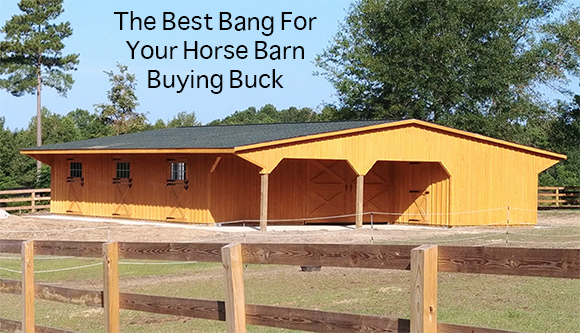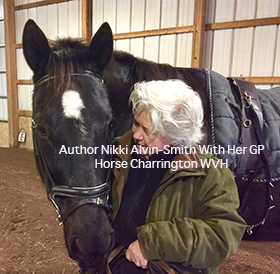The Best Bang For Your Horse Barn Buying Buck
By Nikki Alvin-Smith

When it comes to buying a horse barn there are many options available. The most budget friendly horse housing is a run-in shed or shedrow barn, but for many horse owners the horse barn they desire is more than just a place for stalls for stabling, it is also a structure to store equipment, feed, hay and bedding and a place to groom and tack up their horses.
The option of building a barn on site, either in a stick-built or pole barn fashion, is a traditional method of creating a structure that can incorporate all the various needs for shelter and workspace. Increasingly popular is the option of modular construction. An instant installation of a complete structure with full customization options that is delivered to a prepared site and set up in one or two days is an attractive idea. When you add in the lack of construction delays due to poor weather, the less mess and stress, noise, mud and mayhem, the modular barn purchase with a known ‘to the penny’ price becomes even more appealing.
A benefit to the Low Profile modular build versus a High Profile structure, is that access to your site and site selection itself will be simplified. Low hanging tree limbs or other site access issues will be minimized. It is even possible to move a Low Profile modular structure if you decide you need it at another location.
The most budget friendly barn design within the framework of modular construction is the low profile horse barn. Backyard horse owners with one or two horses can have part of the building designated as stall space, and have space for a tack room, hay and feed storage and a wash stall. Low profile barns can be designed to house one or two horses to 50.
As all storage is on the ground floor, the need for an elevator to store hay in a loft or arduous tasks of stacking hay and hefting heavy sacks of grain upstairs is avoided. Ground level storage can be accomplished by driving an ATV, Gator, tractor or other piece of equipment into the building saving the horse caregiver much toil.
The barn can be closed up for security, with doors that can be shut in harsh weather and a center aisle space can provide valuable space for tacking up and grooming chores.
The inexpensive and highly recommended addition of an overhang, either on one side of the barn or both, provides additional protection from adverse hot or cold weather.
The low profile barn blends well into any landscape, and will not overshadow a one -story home or other structures that exist on the property. A pleasing perspective should be part of any barn design project, and just because the barn is low profile doesn’t mean it can’t be chic and offer a stylish addition to the property.
The low profile nature of the barn will not cause affront to nearby neighbors, as the roofline is approximately 13’ high (versus 22’ for a High Profile barn with loft), so proximity of the barn to the neighbor’s property lines will not obstruct their light or view.
The choice of siding and roofing materials that are available from leading modular barn builders can be a boon to the selection process, facilitating a complementary look to become an integral part of the overall architectural design of the property.
The fact that the low profile barn is a cost effective ‘full’ barn solution makes it an extremely popular choice amongst dollar savvy horse owners and truly offers a good ‘bang for the horse barn buying buck.’
There are some caveats to take into consideration. The structure must be properly engineered to withstand the regional snow and wind loads. It is important that the construction company is experienced in modular design and it is wise to choose one that has proven experience working with horses.
The height of the sidewalls and rafters should accommodate the height of an average horse, and not pose a risk for the horse(s) to injure themselves when excited or exuberant in the stall. A minimum height of ten feet is a good rule of thumb. If you plan on housing larger breeds such as draft horses or warmbloods then wall heights of 12 feet or higher may be necessary.
It is smart from a value added perspective, not to build a building with tiny stalls even if you currently own miniature horses or donkeys, as when comes time to move your barn won’t add value to the sale for the prospective purchaser who owns of average size horses.
If you currently run a horse boarding operation, horse rescue program or training facility the affordability of a small low profile horse barn and its quick implementation can provide the perfect solution for a quarantine facility.
Many larger modular barn building companies offer financing options to help defray the worries over cash flow, and allow horse owners to move their horses from expensive livery options with all the frustrations that can accompany keeping their horses at board, to their own backyard, making their horsekeeping dream a reality.
Speaking as someone with over 50 years experience keeping horses at home, that began with the care of two donkeys and today encompasses a stable of breeding and dressage horses, this author attests there is truly nothing better than living that dream.
 For this author, being able to visit with your horse any time of day or night, take full responsibility for it’s care and maximizing the amount of hours you can spend with your equine partner without impediment, take the pleasures of horse ownership to a different level. It’s not for everyone as it does require dedication and diligent daily care and can limit time spent away from home on vacations and other outings. But for this British gal, it’s an experience I wouldn’t change for the world.
For this author, being able to visit with your horse any time of day or night, take full responsibility for it’s care and maximizing the amount of hours you can spend with your equine partner without impediment, take the pleasures of horse ownership to a different level. It’s not for everyone as it does require dedication and diligent daily care and can limit time spent away from home on vacations and other outings. But for this British gal, it’s an experience I wouldn’t change for the world.


